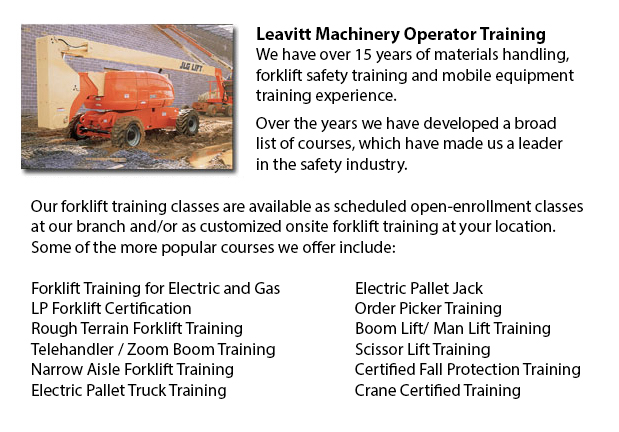
Boom Lift License Langley - To be able to operate an aerial boom lift, operators should be certified through training which could be attained utilizing both classroom sessions and practical training and by attaining a boom lift license. Instruction must be given with respect to the kind of aerial lift that would be used on the job. A License is needed for anyone who works on or operates an aerial boom lift.
Various types of vehicle-mounted aerial devices include extensible boom platforms, aerial ladders, vertical towers, articulating boom platforms, and whatever combination of these types.
There are several basic safety regulations which apply to all boom lifts. Worker safety while inside the basket is a main concern. Workers must have on a body harness and lanyard attached to the boom or basket. Never tie off to an adjacent pole, structure, or equipment. Staff should stand on the basket floor, and never sit or climb on the basket edge. The manufacturer's load limitations must be followed.
Lift operators should be authorized to operate an aerial lift. The manufacturer's guidebook should be kept in the lift and the operator should be familiar with all aspects of that specific unit. Operators are responsible for ensuring that safety procedures are followed in operating the lift. A daily test of lift controls should be done. Set brakes and position outriggers (if they are used) on pads or a stable surface. If working on a slope, use wheel chocks.
The aerial lift vehicle should never be moved whilst a worker is in the basket of an elevated boom, unless they are making use of machinery which are specifically designed for this. Extensible boom platforms and articulating boom used as personnel carriers should have accessible, plainly marked, upper controls. Except in emergency conditions, lower controls must not be used to override upper controls unless permission has been given by the person within the lift.
While working from an aerial lift, do not wear pole or tree climbers.
The insulated part of the aerial lift must not be altered.
Make certain that the booms are carefully checked, that the machinery is properly cradled and the outriggers are in the stowed position before moving.
Make certain that lifts being used in or near power lines are di-electrically tested and conform to local rules.
-
Boom Lift Certification Langley
Boom Lift Certification Langley - Making use of elevated work platforms allow for maintenance operations and work to be performed at elevated work heights which were otherwise unreachable. Boom Lift Certification Training educates workers about safel... More -
Boom Lift Training Langley
Boom Lift Training Langley - Elevated work platforms, likewise referred to as aerial platforms, enable workers to carry out tasks at heights which would otherwise be unreachable. There are various types of lifts intended for various site applications... More -
Wheel and Track Loader Training in Langley
Lift trucks are available in a variety of various units that have varying load capacities. The majority of typical lift trucks used in warehouse settings have load capacities of 1-5 tons. Larger scale models are used for heavier loads, like loading s... More -
Counterbalance Forklift License Langley
Counterbalance Forklift License Langley - When operated by completely trained operators, forklifts could become a major advantage for firms and companies. We can offer your employees a thorough training program which consists of all factors of operat... More -
Aerial Lift Ticket Langley
Aerial Lift Ticket Langley - A boom truck is frequently recognized by the cable and telephone company vans that have the elongated arm folded over their roofs. Commonly, a bucket-like apparatus sits at the extension of extendable arms. Often termed a... More -
Aerial Lift Training Langley
Aerial Lift Training Langley - An aerial work platform is a mechanized access platform. This particular device provides access to otherwise not accessible places for equipment or people. Likewise known as an aerial device or elevating work platform,... More -
Wheel Loader Operator Training Langley
Wheel Loader Operator Training Langley - To be able to raise considerable weights, industrial cranes utilize pulleys and levers. In the past, Romans utilized cranes to construct huge monuments making the origin of these equipment at least two thousan... More -
Manlift Safety Training Langley
Manlift Safety Training Langley - It is important for competent Manlift operators to be aware of the connected dangers which come with particular kinds of scissor lifts. They must be able to operate the scissor lift in a way that protects not just th... More

Forklift Training Langley
TOLL FREE: 1-888-254-6157
Langley, British Columbia
forklifttraininglangley.com
Email Us
About Us


